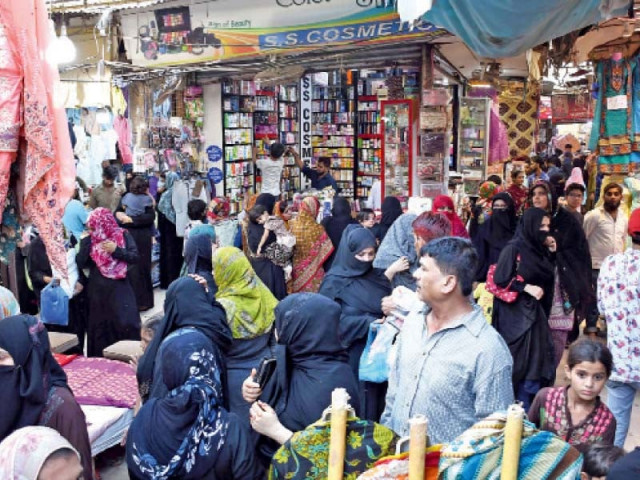Provinces back plan to shutter markets early
NEC approves Rs2.23 trillion bloated national development outlay

As part of the government’s ongoing measures to nip the burgeoning power crisis in the bud, the National Economic Council (NEC) on Wednesday agreed in principle on the closure of markets by 8:30pm in all provinces.
The plan to down the shutters came for consideration a day after the federal cabinet contemplated the move to maximise the use of daylight as part of the government’s austerity measures to deal with the energy crunch.
The government is scrambling to balance its books amid a fierce squeeze on energy and shrinking room for spending, with intense heat showing no signs of abating. With power shortfall whizzing skywards, the PML-N-led government is imposing energy austerity measures to conserve power.
During the NEC meeting, chaired by Prime Minister Shehbaz, the chief ministers of all provinces agreed to the decisions of the federal cabinet.
The centre and the four provinces on Wednesday agreed, in principle, about the need for early closure of markets for energy conservation and reducing fuel import bill.
The participants were apprised of the recommendations and the decisions reached during the high-level meeting held on June 7.
The chief ministers of Sindh, Punjab and Balochistan sought two days' time to carry out consultation with the trade and business organisations in their provinces on the subject.
Also read: Cabinet cobbles up plan to rein in debilitating energy crisis
Development outlay
The National Economic Council also approved a bloated Rs2.23 trillion outlay for the development of the country and set the economic growth rate target at 5% amid confusion in the government over the extent of the external sector crisis and mitigation measures.
The constitutional body also approved the inflation target at 11.5% for the fiscal year 2022-23. But for the first time, the NEC did not approve targets for the trade deficit, exports and imports, indicating that the government has no clue how the external sector will behave.
The NEC is mandated to approve the country’s macroeconomic framework and the National Development Outlay for the Centre, four provinces, Gilgit Baltistan and Azad Jammu & Kashmir.
The NEC also clipped the wings of the departmental development working party by lowering its project sanctioning authority from Rs2 billion to Rs1 billion and that of the central development working party from Rs10 billion to Rs7.5 billion. The step has been taken after a mushroom increase in the number of projects approved by these two bodies.
Moreover, the council approved allocations to the tune of Rs2.232 trillion under the national development spending plans for the next fiscal year – higher by Rs396 billion or 22% over the outgoing year’s revised uplift budgets of the Centre and the provinces.
Billions for MPs amid belt-tightening
Surprisingly, in a move that suggests a total disregard for the country’s thin fiscal position, the NEC also approved Rs70 billion for parliamentarians’ schemes. This is contrary to the government’s austerity drive as most of these expenses are wasted due to a lack of proper checks and controls on these schemes.
The four provinces will spend Rs1.432 trillion from their own resources while the federal government has allocated Rs800 billion for the federal Public Sector Development Programme (PSDP).
Of the Rs2.232 trillion, an amount of Rs300 billion or 14% will be borrowed from abroad to fund these schemes. The federal government will take Rs64 billion and the four provincial governments have a plan to take Rs236 billion in foreign loans in the next fiscal year.The proposed federal PSDP is higher by Rs250 billion or 45% over this year’s revised budget of Rs550 billion. The Ministry of Finance has indicated only Rs727 billion to the Planning Ministry for the PSDP.
The four provincial governments have indicated Rs1.432trillion spending plans -- higher by Rs146 billion or 11.3%, slightly higher than what they indicated last week.
The Punjab government has proposed spending Rs650 billion on development in the next fiscal year, higher by Rs19 billion or 3%. The Sindh government has proposed Rs352 billion under the annual development plan, up by 62% or Rs135 billion over this year’s revised allocation.
The Khyber-Pakhtunkhwa (K-P) government, too, has indicated Rs293 billion spending plan -- up by Rs47 billion or 19%. But the Balochistan government has shown a 29% reduction in spending for next year, down from Rs192 billion to Rs137 billion.
Gravity of economic situation
However, the directions given by PM Shehbaz Sharif during the meeting suggested that the rulers have not yet fully grabbed the gravity of the economic situation.
The sources privy to the meeting proceedings said the PM wanted that half of the next fiscal year’s Rs800 billion PSDP should be given for new development projects. After a debate, he directed that at least 40% of the next PSDP should be given to the new schemes. This will adversely affect ongoing schemes.
The premier also wanted the next fiscal year’s economic growth target should be set at 6%.
The Finance Secretary Hamid Yaqub Sheikh and the Minister of State for Finance Dr Aisha Pasha reminded Shehbaz Sharif that the economy was already passing through a difficult phase and there was overheating, leaving no room for monetary and fiscal expansionary policies.
The NEC approved 5% economic growth and 11.5% inflation targets for the next fiscal year.
The NEC working paper noted that the economy started overheating before the start of the fiscal year, however, the budget 2021-22 added fuel to the fire by adding aggregate demand pressures through the reduction of taxes on luxury items like cars.
It underlined that the recipe for disaster was furthered through concessional financing for construction. The tenuous spillover between growth acceleration and the external sector vulnerabilities resurfaced.
Reluctantly, demand management was packaged in a mini-budget in January 2022, however, it was immediately diluted by a drastic reduction in taxation on domestic consumption of petroleum products and subsequently started subsidising domestic consumption of petroleum which is regarded as the most heavily taxed item across the globe.
The NEC approved the current account deficit target for the fiscal year 2022-23 at 2.2% of gross domestic product (GDP), or $9.1 billion. But it did not fix the trade deficit, exports and imports targets, which now leaves the current account deficit target in the air.
The NEC working paper briefly mentioned the exports and the imports without giving any targets. “External sector will improve upon import compression measures. Export outlook will be impacted by global demand compression and increasing protectionism tendencies in the world”.
The sources said that the conservative assessments showed that the trade deficit could be in the range of $33 billion to $36 billion in the next fiscal year. The imports may remain in the range of $71 billion to $72 billion in the next fiscal year, they added. The export target could also not be agreed upon among the stakeholders.
In the outgoing fiscal year, the current account deficit is estimated at $16 billion, or 4.1% of GDP.
While approving the overall 5% GDP growth rate, the NEC approved the agriculture sector growth target at 3.9%, manufacturing at 7.1% and services at 5.1%.
The NEC approved the average inflation target at 11.5% for the next fiscal year, indicating that the annual inflation rate would remain far higher than the benchmark, as the government had started increasing the prices of fuel, electricity and gas for the sake of the International Monetary Fund (IMF) loan deal.
For the outgoing fiscal year, the previous government had approved the inflation target at 8%, but it would stay higher at 13.3%, showing the failure of the State Bank of Pakistan (SBP) that is now responsible for containing inflation to the government-guided targeted level.
The investment level for 2022-23 is expected to decrease to 14.7% of GDP due to stabilization and the uncertain economic environment while the national savings rate is targeted at 12.6% of GDP.
The body further approved 49% of the total PSDP or Rs394 billion for the infrastructure sector. The transport and communication sector will receive Rs201 billion with some major allocations made for road projects passing through Balochistan.
The energy sector has been given only Rs77 billion. The water resources will receive Rs91 billion.
The social sector bagged Rs166 billion or nearly 21% of the federal budget. The Higher Education Commission received nearly Rs44 billion. The health ministry has been given Rs12.6 billion.
The agriculture sector has been given Rs11 billion or 1.3% of the budget. Likewise, the National Highway Authority (NHA) will get Rs120 billion or 15% of the budget.
The Pakistan Atomic Energy Commission (PAEC) will get Rs26 billion and the Power Division Rs44 billion.The provinces and special areas have been allocated Rs134 billion aimed at accommodating allied parties' development projects and finishing a few ongoing schemes. For K-P’s merged districts, the government has approved an allocation of Rs50 billion for the next financial year.
Azad Jammu and Kashmir (AJK) and Gilgit-Baltistan have been given Rs29.4 billion and Rs25 billion for development respectively.
Similarly, the Pakistan Railways has been given Rs33 billion for the next fiscal year. The government has allocated Rs8.7 billion for “Viability Gap Funding” to encourage the private sector’s investment in infrastructure.



















COMMENTS
Comments are moderated and generally will be posted if they are on-topic and not abusive.
For more information, please see our Comments FAQ